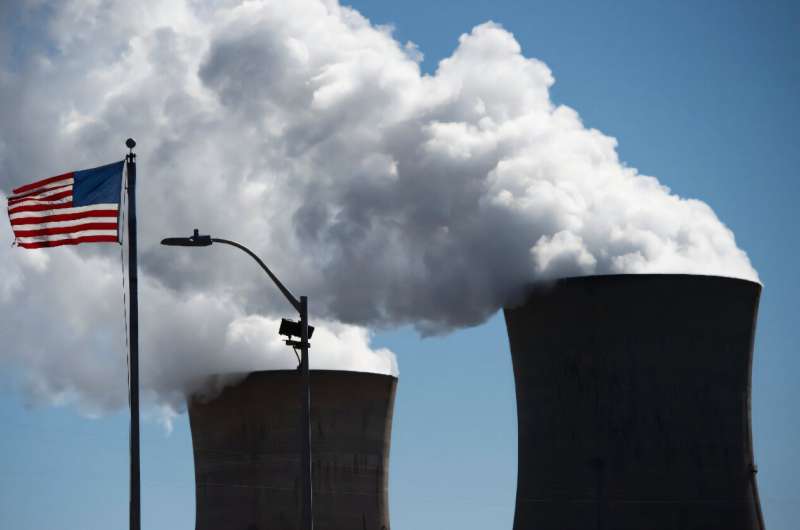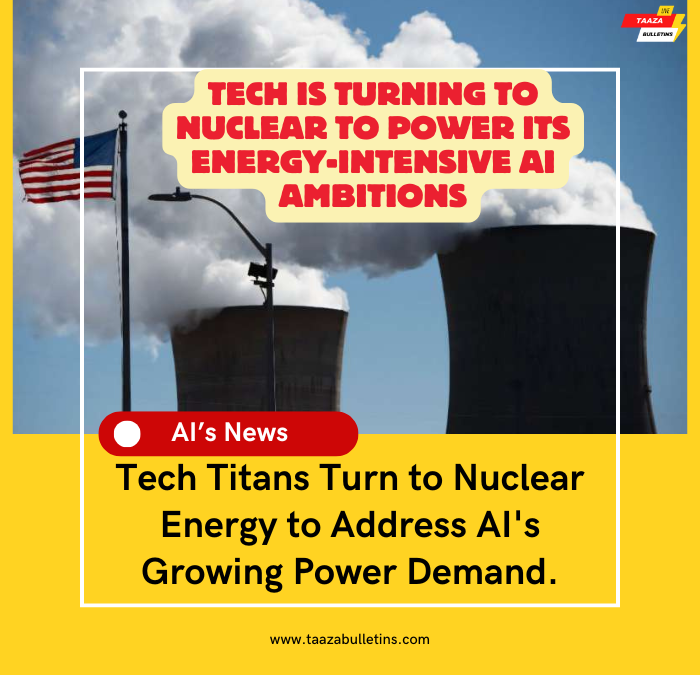Why Big Tech is embracing nuclear energy to support its energy-intensive AI goals.
Table of Contents
The competition in artificial intelligence has escalated significantly. Amazon, Microsoft, and Google are now striving to surpass one another with initiatives related to nuclear energy, which they believe will support a technology that is rapidly increasing its electricity consumption.

These leading technology firms, recognizing AI as the forthcoming pivotal advancement in the industry, are allocating billions to enhance their global data center infrastructure.
Research from Goldman Sachs indicates that by 2030, data centers are projected to account for 8 percent of the United States’ power consumption, a rise from 3 percent in 2022.
In Europe, the energy requirements of these centers by 2030 are expected to equal the total current consumption of Portugal, Greece, and the Netherlands combined.
The primary motivation behind this trend is the desire of tech giants to develop superior AI systems through increasingly larger data centers, which result in substantial electricity usage and carbon dioxide emissions.
As these companies search for energy solutions to fulfill their needs while adhering to their commitments to zero carbon emissions, nuclear energy has surfaced as an attractive alternative.
Despite the high costs and political challenges associated with its development, nuclear power offers a stable, zero-carbon energy source once it is operational.
Jacopo Buongiorno, a Professor of Nuclear Science and Engineering at MIT, stated, “Tech companies aren’t enamored with nuclear, but they require carbon-free, reliable, and consistent energy around the clock. The expense may be considerable, yet it is predictable for a duration of 60 years.”
Recently, major technology companies have significantly invested in nuclear power, revitalizing a clean energy source that has experienced a decline (the United States currently operates 94 nuclear reactors, a decrease from a peak of 112 in 1990). It is noteworthy that nuclear energy accounts for 19% of the electricity generated in America, while fossil fuels contribute 60%. Companies such as Microsoft, Google, and Amazon are actively seeking nuclear power to support their AI data centers, which have high energy demands.
This month, Amazon and Google entered into agreements with startups focused on developing small modular reactors, which can be constructed more quickly and at a lower cost. Google anticipates beginning to utilize these reactors by 2030, although they will represent only a minor portion of its total electricity needs.
Constellation Energy has announced plans to invest $1.6 billion in renovations for the decommissioned Three Mile Island nuclear plant, with the goal of restarting operations by 2028. Microsoft has indicated that it will purchase all available power from this facility for a duration of 20 years once it is operational again.
Additionally, the federal government is also involved: Holtec, a nuclear technology firm, has recently secured a $1.5 billion loan from the Department of Energy to restart a nuclear reactor in the United States for the first time.
The surge in demand for data centers, driven by the AI race, has led to the establishment of over 5,000 data centers across the United States, with a remarkable 25% growth in major markets during the first quarter compared to the previous year. This increased activity is benefiting industrial property leaders such as Prologis and Blackstone, allowing them to navigate a slowdown in warehouse construction. Prologis has announced plans to invest $8 billion in data center development over the next five years, while Blackstone recently acquired a data center operator for $16 billion.
This week, Google announced it would buy power from Kairos Power, a developer of small modular reactors, to support its AI advancements. Last month, Microsoft struck a deal with U.S. energy firm Constellation to revive a defunct reactor at the infamous Three Mile Island nuclear power plant in Pennsylvania. Major tech companies are increasingly exploring alternative energy sources like nuclear to meet the rising energy demands of data centers.
‘Huge numbers’
Nuclear reactors entail significantly higher construction costs compared to solar or wind energy facilities, making nuclear energy a viable option primarily for large technology companies that generate substantial annual profits.
Rob Bittencourt from Apollo Global Management highlighted that the data center expansion within the industry has reached a staggering trillion dollars, with a correspondingly vast demand for electricity to support this power generation.
“These figures are considerable, yet companies like Amazon, Meta, Microsoft, and Google are positioned to invest for the long term,” he remarked during an appearance on the Odd Lots podcast.
Various strategies are currently under evaluation.
One approach focuses on prolonging the operational lifespan of older nuclear facilities. Recently, Microsoft entered into a 20-year agreement with Constellation Energy to reactivate Unit 1 at Three Mile Island, which had been decommissioned five years prior due to economic factors.
This announcement resonated deeply, as the 1979 partial meltdown of Unit 2 at the same location incited widespread fear in the United States and halted the growth of nuclear energy.
In a similar vein, Amazon Web Services (AWS) is utilizing the 40-year-old reactor at Susquehanna Steam Electric Station to supply power to a nearby data center complex.
“Unwelcome surprises”
One alternative strategy involves investing in Small Modular Reactors (SMRs). These compact reactors, which are potentially simpler to deploy, remain in the experimental phase.
Amazon has made commitments to SMR initiatives, including a direct investment in the start-up X-energy. Meanwhile, Google is collaborating with Kairos Power to create SMRs that may become operational by 2030.
Nevertheless, several challenges persist. The reliability of SMR technology is not yet guaranteed, and the major tech companies involved lack substantial experience in nuclear projects, which could lead to unforeseen complications, as noted by Buongiorno.
Safety issues continue to be a concern, particularly in light of past nuclear incidents such as Chernobyl and the Fukushima disaster in Japan in 2011.
Despite these obstacles, leaders in the industry maintain a positive outlook.
Bill Gates, the founder of Microsoft, is investing billions in his own SMR venture, Terrapower. He recognizes the challenges but remains optimistic about advocating for nuclear power’s significance in a future driven by artificial intelligence.
Construction of his project has commenced in Wyoming, although it is still pending approval from the U.S. nuclear regulatory authority.
“I am investing billions because I am quite confident we can substantiate that argument,” he stated at a recent event in New York.
Why they’re turning to nuclear
Tech companies are facing increasing pressure to identify sustainable energy sources to power their data centers, which are essential for contemporary cloud computing and artificial intelligence applications.
Numerous developers opt to lease servers equipped with graphics processing units (GPUs) from major cloud providers, often referred to as “hyperscalers,” including Amazon, Microsoft, and Google, as the cost of outright ownership is typically prohibitive.
These technology leaders have experienced a significant rise in interest surrounding generative AI applications, such as OpenAI’s ChatGPT. However, this surge in demand has inadvertently resulted in substantial increases in energy consumption.
According to a research report from the International Energy Agency, global electricity usage from data centers, artificial intelligence, and the cryptocurrency industry is projected to double from approximately 460 terawatt-hours (TWh) in 2022 to over 1,000 TWh by 2026.
A study conducted by researchers at the University of California, Riverside, published in April of the previous year, revealed that ChatGPT utilizes 500 milliliters of water for every 10 to 50 prompts, depending on the timing and location of the AI model’s deployment. This amount is roughly equivalent to the water contained in a standard 16-ounce bottle.
As of August, OpenAI reported that over 200 million individuals were submitting inquiries to its widely used chatbot, ChatGPT, each week, which is double the 100 million weekly active users reported in November of the previous year.
Environmental opposition
Nuclear energy remains a subject of significant debate. Numerous climate activists express their opposition to this energy source, highlighting its potential environmental hazards and safety concerns, as well as its failure to provide a true renewable energy alternative.
According to Greenpeace, a prominent climate advocacy organization, nuclear power is characterized by high costs, inherent dangers, and lengthy construction timelines. The organization notes that while nuclear energy is often labeled as “clean” due to its lack of carbon dioxide and other greenhouse gas emissions during electricity generation, it ultimately does not serve as a viable substitute for renewable energy options.
Conversely, supporters of nuclear energy argue that it presents a nearly carbon-free electricity generation method and offers greater reliability compared to renewable sources such as solar and wind.
Rosanne Kincaid-Smith, the chief operating officer of Northern Data Group, a global data center provider, expressed her views at a recent technology conference in London, stating, “If it is constructed and secured appropriately, I believe nuclear energy represents the future.” She acknowledged the public’s apprehension regarding nuclear power, stemming from historical disasters, but emphasized that traditional energy grids may not sustain the ongoing demands of artificial intelligence development.
Although Northern Data Group is not currently utilizing nuclear energy and has no immediate plans to incorporate it into its AI data centers, Kincaid-Smith indicated the company’s desire to engage in discussions about nuclear energy’s role, recognizing its significance for the broader ecosystem and economy.
